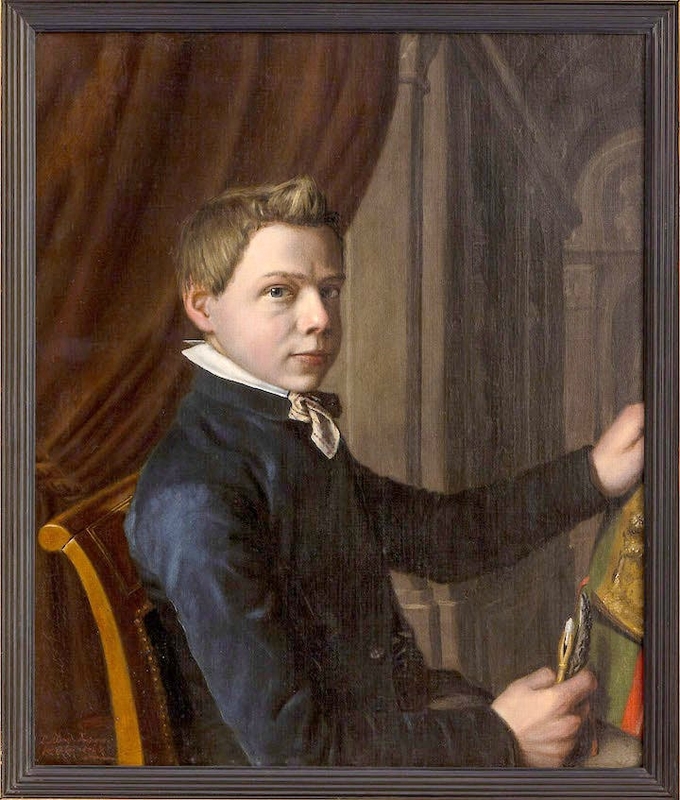Leighton House Museum opens the first Alma-Tadema exhibition in London since 1913
Sir Lawrence Alma-Tadema (1836-1912), In my Studio, 1883. Collection of Ann and Gordon Getty.
LONDON.- Alma-Tadema: At Home in Antiquity, the first major exhibition in London since 1913 to be devoted to one of the most popular artists of the Victorian era, is now open at Leighton House Museum. With over 130 works, Leighton House Museum is the only UK venue for the exhibition, following an exceptionally successful tour to the Museum of Friesland, Leeuwarden, the Netherlands (the artist’s home town) and the Belvedere, Vienna, Austria.
Alma-Tadema: At Home in Antiquity explores all phases of the artist’s career with a particular focus on his fascination with the representation of domestic life in classical antiquity and how this interest was expressed in the two remarkable studio-houses he created in London with his wife Laura and his two daughters. Laura frequently posed at home for her husband’s paintings and was also a gifted and successful artist in her own right. The exhibition includes over a dozen pictures by Laura and AlmaTadema’s daughter Anna, highlighting the close connections between their domestic and creative lives.
Sir Lawrence Alma-Tadema (1836-1912), Coign of Vantage, 1895. Collection of Ann and Gordon Getty.
With this emphasis on the importance of the home and studio as a creative inspiration, the exhibition finds a perfect setting at Leighton House Museum built by Alma-Tadema’s friend and contemporary Frederic Leighton. With its extensive use of marble, gilding and mosaics, Leighton’s house contains the same palette of materials so expertly painted in many of Alma-Tadema’s pictures and allows an understanding of why Leighton, Alma-Tadema and other artists of their generation invested so much in the creation of a ‘private palace of art’.
Daniel Robbins, Senior Curator at Leighton House Museum says: ‘This is the largest exhibition that we have ever put on. It is only appropriate that the works of Alma-Tadema, his wife and daughter are regrouped and shown in surroundings that would have been familiar to all the family members. Leighton’s home and their life in London provides a missing piece of the puzzle in understanding the work of this great Victorian artist.’
Sir Lawrence Alma-Tadema (1836-1912) The Kiss, 1891 Private Collection, Courtesy of Martin Beisly.
Born Lourens Tadema in the north of the Netherlands in 1836, the artist trained in Belgium before settling in London in 1870. Alma-Tadema rose to enjoy great popular and critical acclaim and the rewards of a highly lucrative career, famed for his engaging depictions of classical antiquity and his great technical accomplishment in the skilled rendering of surfaces and materials.
Alma-Tadema: At Home in Antiquity take visitors on a journey through the interiors of Leighton House Museum, each one presenting a different aspect of Alma-Tadema’s life and work in succession. Starting in the Drawing Room, Alma-Tadema’s earliest works are displayed, including an assured self-portrait painted at the age of 16 and early historical subjects of the 1850s. A visit to Pompeii on his honeymoon in 1863 proved transformative, inspiring Alma-Tadema to depict carefully researched scenes of Roman life, often with a focus on the minutiae of day-to-day activity. The Dining Room and Silk Room follow his career through the 1860s and 1870s as his trademark paintings of life in antiquity began to emerge and his London career started to flourish. The Alma-Tademas’ first London house close to the Regent’s Canal will be explored in Leighton’s Bedroom and the second, larger house in Grove End Road in Leighton’s Studio. Presented here through photographs, personal artefacts, drawings and paintings, the interiors of the houses became inspirational settings for Alma-Tadema’s work. Also included are a selection of the panels painted by Alma-Tadema’s artist friends and contemporaries, including Leighton, which adorned the interiors of his house and which have been reunited for the exhibition. The Studio also houses the portrait of Leopold Löwenstam, a friend and colleague of the artist, rediscovered on the BBC’s Antiques Roadshow in 2016 publicly displayed for the first time since its discovery.
Sir Lawrence Alma-Tadema, A Pyrrhic Dance, 1869 Guidhall Art Gallery, City of London.
The Winter Studio houses an audio-visual presentation exploring connections between AlmaTadema’s pictures and cinematic representations of ancient Greece and Rome. Particularly evident in the first decades of cinema in both Europe and Hollywood his influence has continued and is acknowledged by the makers of more recent films including Ridley Scott’s Gladiator (2000).
The exhibition culminates in the Perrin Gallery where the major works of Alma-Tadema’s late career are displayed, reuniting, amongst other paintings, The Finding of Moses (1904; Private Collection), the sumptuous presentation of the biblical tale which achieved the highest price for a Victorian painting when it was sold in 2010, with one of Alma-Tadema’s last major works, the renowned The Roses of Heliogabalus (1888; Private Collection). Both works were originally commissioned by Sir John Aird and are reunited for the first time in this exhibition.
Sir Lawrence Alma-Tadema (1836-1912), The Finding of Moses, 1904. Private Collection.
Sir Lawrence Alma-Tadema (1836-1912), The Roses of Heliogabalus, 1888. Perez Simon Collection.
Sir Lawrence Alma-Tadema (1836-1912), Portrait of Leopold Lowenstam, The Etcher, 1883, Private Collection, England.
Self-Portrait of Lourens Alma Tadema, 1852 Fries Museum, Collection Royal Frisian Society.

/https%3A%2F%2Fprofilepics.canalblog.com%2Fprofilepics%2F1%2F0%2F100183.jpg)
/https%3A%2F%2Fstorage.canalblog.com%2F03%2F02%2F119589%2F96711876_o.jpg)
/https%3A%2F%2Fstorage.canalblog.com%2F11%2F31%2F119589%2F94773502_o.jpg)
/https%3A%2F%2Fstorage.canalblog.com%2F20%2F83%2F119589%2F94772815_o.jpg)
/https%3A%2F%2Fstorage.canalblog.com%2F26%2F72%2F119589%2F75604929_o.jpg)
/https%3A%2F%2Fstorage.canalblog.com%2F59%2F60%2F119589%2F26458628_o.jpg)










/http%3A%2F%2Fstorage.canalblog.com%2F58%2F08%2F119589%2F128955783_o.jpeg)
/image%2F1371349%2F20240423%2Fob_b2fe42_telechargement-9.jpg)
/image%2F1371349%2F20240423%2Fob_af8bb4_telechargement-6.jpg)
/image%2F1371349%2F20240423%2Fob_b6c4a6_telechargement.jpg)